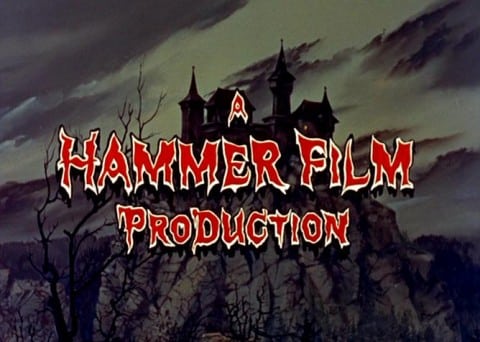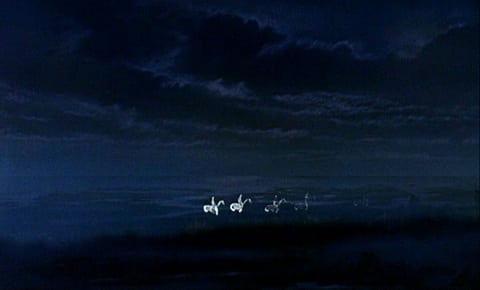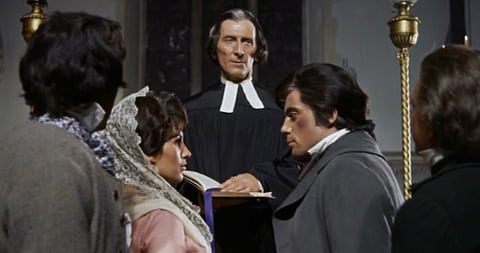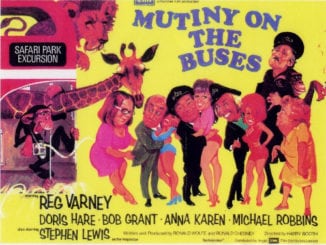Captain Clegg (1962)
Directed by: Peter Graham Scott
Written by: Anthony Hinds, Barbara S. Harper, John Temple-Smith, Peter Graham Scott, Russell Thorndike
Starring: Oliver Reed, Patrick Allen, Peter Cushing, Yvonne Romain
AKA NIGHT CREATURES
UK
ON BLU-RAY AND DVD
RUNNING TIME: 82 min
REVIEWED BY: Dr Lenera, Official HCF Critic
1776: a ‘mullato’ [somewhat derogatory term for a person with both ‘black’ and ‘white’ parents] is brutally punished for raping the pregnant wife of the ruthless Captain Clegg. 1792: an old man is scared to death at Romney Marsh, just outside the village of Dymchurch, by the ‘marsh phantoms’ which supposedly haunt the area. The next day, Captain Collier brings a team of revenue men to Dymchurch, determined to prove that the village is harbouring a covert booze smuggling operation, and pours scorn on the reports of ghosts despite the body of the old man turning up. In fact a smuggling operation is indeed going on, and it is masterminded by the local vicar Dr. Blyss. He tries to stop Collier and his lot, who have also brought the ‘mullato’ along with them to help, from finding out what he’s up to. Meanwhile lovesick villager Harry Hobtree wants to run away with barmaid Imogene, but her guardian has his own feelings for her….
For some reason I’d had Captain Clegg, under its American title of Night Creatures [actually the name of a proposed Hammer adaptation of Richard Matheson’s novel I Am Legend – later filmed as The Last Man On Earth, The Omega Man and with its own title – which had been vetoed by the BBFC in 1857], in my collection for several years and had just forgotten that I owned it. Strictly speaking, it’s another Hammer which isn’t really a horror and, in giving it a full length review, perhaps I’m once again breaking my promise to just give lengthy reviews to the horror and fantastical features of the studio’s output, and do short write-ups for all the others. However, it definitely has its macabre aspects, is quite dark and brutal for what was intended as a family movie, and seems to exist right on the edge of the world of Hammer horror without delving fully into it. It’s also, within its obvious limitations, a fine film which should satisfy as long as one doesn’t go into it expecting a full blown Gothic chiller. Full of charm, with an exciting story and another terrific Peter Cushing performance, it deserves to be regarded [though many Hammer fans do seem to love it – it’s just that the film doesn’t seem to be seen or appreciated much outside of Hammer fandom] as one of the studio’s most interesting, and even purest movies. It may not be full of blood or shock moments, but this is quintessential Hammer, a perfect example of their style and craftsmanship.
The origins of Captain Clegg go back to a series of novels by Russell Thorndike featuring a smuggler anti-hero called Dr. Christopher Syn. The first, Dr Syn: A Tale Of The Romney Marsh, was published in 1915, and was filmed, reasonably faithfully, though with a happier ending for Syn, as Dr. Syn in 1937. It was Major Films, an Independent production company headed by producer John Temple-Smith and director Graham Scott, who approached Hammer with the idea of remaking it. However, a lengthy legal dispute with Disney, who had also bought the rights to the whole series of books, ensured. A compromise resulted, with Hammer allowed to make their film, but to not use the name Dr. Syn, and Anthony Hinds, with help from Major Films alumni Barbara S. Harper, rewrote Temple-Smith’s and Scott’s script accordingly, also altering other names in what was then called The Curse Of Captain Clegg and changing other details. Smarting from the legal costs resulting from the dispute, Hammer scaled down the production, which was originally intended to shoot in Canada, and it ended up being filmed at Bray Studios, nearby Braywood Church, Cobham in Surrey, and Denham in Buckinghamshire, also utilising tinted shots from the 1944 Great Expectations. Cushing told off extras for laughing, saying: “Gentlemen, if we don’t believe in what we’re doing, then no one in the audience will. We as actors owe it to them”. The phantoms, which were added to the story, were people wearing black body suits with reflective paint, along with a skull found in Dead Man’s Island, Kent marshland, where French prisoners of war were buried, for close-ups. Released in the UK with The Phantom Of The Opera, the film got little attention and was soon overshadowed by Disney’s three part TV version, which was actually based on the final Syn book, Christopher Syn.
Even though we don’t see the actual violence, this film sure has a strong opening which surprised me in its intensity for what was an ‘A’ [‘PG’] rated picture [it’s been upped to a’12’ for its UK Blu-ray and DVD release, which sounds sensible, though that means that the BBFC now consider this film to be as horrific as The Curse Of Frankenstein], with a man ordered to have his tongue torn out for assaulting the wife of Captain Clegg, before being marooned on an island where he’s tied to a post. Amusingly, it’s the only sea-set scene of what is in part a pirate movie. Then, after the titles and some scene-setting scrolling words which are unnecessarily also accompanied by a voice-over reading them out, we get a fantastically atmospheric scene of considerable eeriness where an elderly man is fleeing in terror from something in the countryside [yes, we’re not far from things like Hound Of The Baskervilles and I half-expected Sherlock Holmes to turn up], something which turns out to be living skeletons on horseback who scare him to death. Now to our modern eyes, it’s obvious that these are men in special suits, which of course they turn out to be in the story anyway, but I reckon quite a few kids in 1961 would have been effectively scared, and even I jumped at a genuinely startling shot where a human eye is seen inside a scarecrow. It also made me sad that, outside of a few thrillers where supernatural activity always turned out to have a logical explanation, Hammer never made a full-on ghost movie. Sadly the phantoms only turn up again near the end, by which time most viewers have probably realised what they really are, but this certainly doesn’t mean that the rest of the film is lacking. Far from it!
When Collier and his group arrive in Dymchurch, the film gives part of the game away almost immediately by letting us know that half the villagers, led by the friendly vicar, are involved in the liquor smuggling business, and I did wonder if the story would have benefited from being more of a mystery, but I soon realised that the way it was being done made for more suspense as well as a surprising amount of moral ambiguity which ends up making the smugglers more sympathetic than the revenue men. Blyss uses the money he makes from his illegal-goings-ons for the benefit of the village and especially to feed and clothe the poor, and, despite his ordering of several killings, the viewer genuinely doesn’t want him to be caught until his true identity is revealed near the end, whereupon the viewer is still quite conflicted. He just wants to do good and atone for his past crimes, and even slows down his escape, in a rather sweet scene that really did warm the cockles of my heart, so he can marry the nominal young hero and heroine in his church. And the end scene of his friend Jeremiah carrying his dead body and burying him is quite touching. By comparison, Collier and his group come across as distinctly unfriendly and even overly vicious the way they seem happy to torture folk for information.
The romantic subplot doesn’t always seem necessary, and it was weird for this viewer to see Oliver Reed get up close and personal with the woman who played his mother in The Curse Of The Werewolf, but does tie in nicely with the main story towards the end, and make no mistake, even here this is quite a tough movie, with attempted rape by Imogene’s guardian and Reed’s character getting roughed up by Collier’s men. Then there’s the vengeful ‘mullato’ [though Milton Reid doesn’t seem half ‘black’ at all] who turns up every now and again and is also quite sympathetic, there even being a scene where he’s virtually abused by the sailors who get him drunk and make him dance and sing though he has no tongue. What with also a certain revelation about Imogene which did take me by surprise, there’s quite a lot going on in this film, a film which still finds time for some decent lines.
Imogene: Well if you’ve all done staring.
1st Sailor Jack Pott: If it’s all the same to you miss, I’d like a few minutes more.
Its first half is overly stately in places and a little too reliant on chat, but the second half moves at a fine pace with much chasing around the marshes and a couple of reasonable fights. Temple Smith’s direction tends to mostly be in the Terence Fisher fashion [the film does look like a Fisher movie for much of the time] but adds a surprising amount of handheld camerawork in some scenes, like when the sailors are marching towards the village, and one odd moment where the screen gets all distorted just before a murder. Arthur Grant’s cinematography isn’t outstanding but does tie the various locations together quite well, and I certainly couldn’t notice the 1944 footage!
Switching from steely boss to stuffy vicar, Cushing is again a joy to watch as he gets his teeth into another fine part. It seems that some of his best work was in roles that aren’t too widely seen or known. He loved this complex anti-hero character so much that he wrote the screenplays for two potential sequels, Dr Syn and Waiting Revenge, but sadly couldn’t get them off the ground. Michael Ripper gets more screen time than normal as coffin maker Jeremiah Kipps. The character even seems to sleep in a coffin, in a film full of odd little touches like the small boy who wants to be a hangman! Reed is a tad uneasy in the role of romantic lead but Yvonne Romain does really well as the ‘serving wench’ full of secrets. This was the first Hammer movie to have a score from Australian composer Don Banks. His work here is suitably dramatic and incorporates some poignant quiet passages, though his themes and motifs are not too memorable, and the phantom scenes could have benefitted from more interesting backing, something Banks would have probably provided a few years on when he got better. Unjustly obscure for decades to the point where it never even came out on video in the UK and the US, Captain Clegg does seem to be appreciated a little bit more nowadays, but it’s a prime example of a film whose popularity has probably suffered from falling between two stools – two dark for the kiddies [though possibly not today’s kids], not dark enough for horror fans – but still has considerable merit nonetheless. Though a little hesitant in some of its early stages, by the end it had totally won me over with its atmosphere, its spirit, its surprising depth, and, even, its pathos. It’s a must see for anyone who likes the Hammer style.
Rating: 


















Be the first to comment